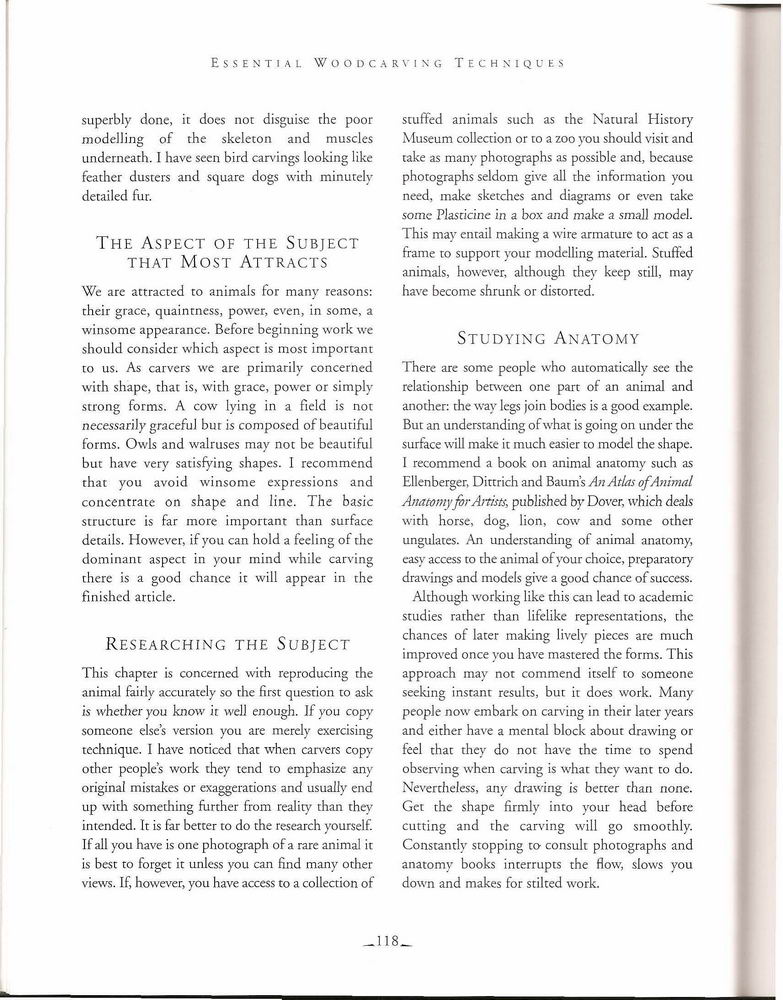essentÊrving±18

Essential W o o d c a r v i n c, T e c h n i q u e s
superbly donc, it docs noc disguise che poor modeiling of the skoleton and musclcs underneath. I havc scen bird carvings looking like fcathcr duscers and squarc dogs with minutely decailed fur.
The Aspect of the Subject that Most Attracts
We arc actracted co animals for many reasons: cheir grace, quaincness, power, even, in some, a winsomc appcarance. Bcforc beginning work we should considcr which aspecc is mosc imporcant co us. As carvcrs we arc primarily concerned wich shape, chat is, wich grace, power or simply strong forms. A cow lying in a field is not necessarily graceful bur is composed of beautiful forms. Owls and walruses may not be beautiful but have very satisfying shapes. 1 recommend chat you avoid winsome cxpressions and concentratc on shape and linę. The basie structurc is far morc important chan surface details. Howevcr, if you can hołd a fecling of the dominant aspect in your mind whilc carring there is a good chance it will appear in che finished arcicle.
RESEARCHING THE SUBJECT
This chapter is concerned with reproducing the animal fairly accuratcly so the first question to ask is wherheryou know it wcll enough. Jf you copy someone elses version you are mcrely exercising technique. I have noticed that when carvers copy other peoplcs work they tend to emphasize any original mistakes or exaggerations and usually end up with something further from reality than they intended. It is far better to do the research yourself. If all you have is one photograph of a rarc animal it is best to forget it unlcss you can find many other views. If, however, you have access to a collection of seuffed animals such as the Natural History Museum collection or to a zoo you should visic and take as many phocographs as possible and, because photographs seldom give all the Information you need, make sketches and diagrams or even take some Plascicinc in a box and make a smali model. This may cntail making a wire armaturę to act as a frame to support your modeiling materiał. Seuffed animals, however, although they keep still, may havc become shrunk or distorted.
Studying Anatomy
There arc some people who automatically sec the relationship becwccn one part of an animal and another: the way Icgs join bodics is a good cxamplc. But an understanding of what is going on under the surface will make it much easier to model the shape. I recommend a book on animal anatomy such as Ellenberger, Dittrich and Baums An Atlas of Animal Anatomy for Artists, published by Do\'er, which deals with horsc, dog, lion, cow and some other ungulaccs. An understanding of animal anatomy, casy access to the animal of your choicc, preparator)' drawings and inodels give a good chance of success.
Although working like this can lead to academic studies rarher than lifelike representacions, the chances of later making lively pieces are much improved once you have mastered the forms. This approach may not commend itself to someone seeking instant results, but it does work. Many people now embark on carving in cheir later years and either have a mcntal błock about drawing or feel chat they do not have the time to spend observing when carving is what they want to do. Nevercheless, any drawing is better chan nonę. Gct the shape firmly into your head beforc cutting and the carving will go smoothly. Constantly stopping co consult photographs and anatomy books interrupts the flow, slows you down and makes for stilted work.
-118_
•- _
Wyszukiwarka
Podobne podstrony:
ablc. The speech docs noc bind mc Ouci Exccunvc or the Erkrean Asscmbly in any way. 23/ 336. Rromuig
mbs 027 MY BREATHING SYSTEM sucked in. For persons who lind it very difficult to acquire tłiis contr
IMG 30 Rozdział VIModele aktów i procesu komunikacji It is interesting to see how some of the influe
essent?rving?56 CHAPTER 15INCISEDLETTERING Lettering is Part of the Message £ T f BRIX don’c spell b
essent?rving?65 INCISED LETTERING scrokes arc perpcndicular to che cap and base lines, curring is ac
Isolation An essential ingredient of any safe system of work is the method and integrity of the isol
kryzysy marokańskie (10) 320 CUAITCR 1 1 advantagc tliat whilc affecting Frcnch intercsts, it docs n
128 Zbigniew ljÄ…)n____ ^ nor on any othcr rclatmg 10 it in ihc mcaning of ihe CodÄ™ of Gwj ProcedurÄ™.
drought Drought DiSOileri This is an Attack tu Destroy any Huge Pldcc. It docs not require da action
10303460R3051641156774?87004606857223310 n 3 . V To calculttlc thc moment Ma solving the eqimtlon nu
Low-Temperature TLC—MS of Essential Oiis from the piąte before elution of the chromatographic bands
Essential Oils of Sagę Species 183ExperimentalPlant Materiał Samples of the two Salina species (S.
więcej podobnych podstron